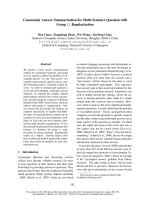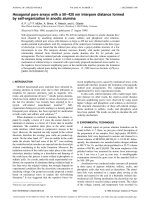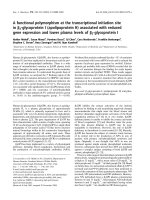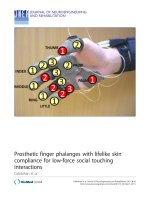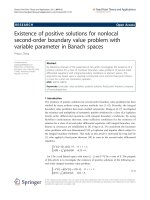Low order multi port arrays with reduced element spacing for digital beam forming and direction finding
Bạn đang xem bản rút gọn của tài liệu. Xem và tải ngay bản đầy đủ của tài liệu tại đây (1.65 MB, 145 trang )
LOW-ORDER MULTI-PORT ARRAYS WITH REDUCED
ELEMENT SPACING FOR DIGITAL BEAM-FORMING
AND DIRECTION-FINDING
CHUA PING TYNG
NATIONAL UNIVERSITY OF SINGAPORE
2004
LOW-ORDER MULTI-PORT ARRAYS WITH REDUCED ELEMENT SPACING
FOR DIGITAL BEAM-FORMING AND DIRECTION-FINDING
CHUA PING TYNG
(B.Eng. (Hons.), NUS)
A THESIS SUBMITTED
FOR THE DEGREE OF MASTER OF ENGINEERING
DEPARTMENT OF ELECTRICAL AND COMPUTER ENGINEERING
NATIONAL UNIVERSITY OF SINGAPORE
2004
SUMMARY
An array of three monopole elements with reduced element spacing of λ / 20 to λ / 6
is considered for application in digital beam-forming and direction-finding. The small
element spacing introduces strong mutual coupling between the array elements, which
affects the signal-to-noise-ratio performance of the array. A decoupling network can
compensate for the mutual coupling effects so that simultaneous matching can be
achieved at all the ports. This thesis discusses decoupling for arrays with three or
more elements and describes the realization of decoupling networks using Kuroda’s
identities. Design equations for the decoupling network are presented. Experimental
results show close agreement with the theoretical predictions.
The decoupled
prototype array has a bandwidth of 1% and a superdirective radiation pattern. This
narrowband and superdirective antenna may find application for frequency selectivity
in digital beam-forming and direction-finding.
i
ACKNOWLEDGEMENTS
I would like to express special thanks to Dr. Jacob Carl Coetzee for his invaluable
guidance and supervision in this project. I am indebted to him for his understanding
and patience in times when problems were faced. It has been an enjoyable experience
working with him. No words can ever fully express the gratitude that I have for Dr.
Coetzee for the valuable experiences and knowledge that he has shared with me.
Thank you.
My thanks also go to the following people who have helped to make this project a
success:
(a)
Mr. Kevin Ho Ming Jiang – for his important and helpful advice.
(b)
Mr. Jalil – for his valuable advice on fabrication of the microstrip network.
(c)
Mr. Victor Liang and Mr. Chin (SQ Engineering & Trading Pte Ltd) – for
manufacturing the antenna structures.
(d)
Mr. Chan (NUS ECE Workshop) – for manufacturing the antenna
structures.
(e)
Mr. Quek and Mr. Sim (INTERHORIZON Corporation Pte Ltd) – for
fabricating the microstrip networks.
(f)
Mr. Sing (NUS Microwave Lab) – for his help in the measurement of the
antenna.
(g)
Mdm. Lee (NUS Microwave Lab) – for her help in the procurement of
materials required.
(h)
My boyfriend, Jialong – for his love, support and encouragement.
ii
CONTENTS
SUMMARY
ACKNOWLEDGEMENTS
CONTENTS
LIST OF FIGURES
I
II
III
VII
LIST OF TABLES
X
CHAPTER 1
INTRODUCTION
1
1
1.1. Background
1
1.2. Objectives of the project
3
1.3. Outline of the project
3
1.4. Organization of the thesis
3
1.5. Publications
4
CHAPTER 2
THEORETICAL BACKGROUND
5
5
2.1. Introduction
5
2.2. Smart antennas and digital beam forming
5
2.3. Theory of mutual coupling
9
2.3.1. Mutual impedance between two linear elements
2.3.2. Mutual coupling in a circular array
2.4. Conclusion
9
11
13
iii
CHAPTER 3
MODELLING OF AN ARRAY ELEMENT
14
14
3.1. Introduction
14
3.2. Antenna elements
14
3.3. IE3D modelling
16
3.3.1. About IE3D software
16
3.3.2. Construction of a monopole in IE3D
16
3.3.3. IE3D simulation settings
17
3.3.4. Radiation patterns from IE3D
18
3.3.5. Troubleshooting for IE3D modelling
20
3.4. HFSS modelling
21
3.4.1. About HFSS software
21
3.4.2. Construction of monopole in HFSS
21
3.4.3. HFSS simulation settings
22
3.4.4. Troubleshooting for HFSS modelling
25
3.5. Conclusion
CHAPTER 4
DECOUPLING OF ARRAY
25
26
26
4.1. Introduction
26
4.2. The need for a decoupled array
26
4.3. Theory of eigenmode analysis
29
4.4. A design for decoupling an array by modifying element length
31
4.4.1. Example A1
34
4.4.2. Example A2
41
4.5. A generalized design for the decoupling network of an array
44
4.5.1. Eigenmode analysis
45
4.5.2. Network analysis
47
4.5.3. Matching network
49
iv
4.5.4. Example B1
50
4.5.5. Example B2
52
4.5.6. Example B3
53
4.6. Analytical solutions for array with more elements
55
4.7. Conclusion
55
CHAPTER 5
DECOUPLING NETWORK IMPLEMENTATION
57
57
5.1. Introduction
57
5.2. Realization of lumped elements
57
5.2.1. Kuroda’s identities
57
5.2.2. Realization of series inductors
59
5.2.3. Realization of series capacitors
60
5.2.4. Realization of shunt inductors and capacitors
61
5.2.5. Summary of realization of ideal components
62
5.3. Preservation of symmetry in decoupling network
63
5.4. Interdigital capacitors as series capacitors
64
5.5. Conclusion
67
CHAPTER 6
EXPERIMENTAL RESULTS
68
68
6.1. Introduction
68
6.2. Construction of antenna hardware
68
6.2.1. Specifications of array element
68
6.2.2. Specifications of antenna support structure
70
6.2.3. The complete array
71
6.2.4. Specifications of microstrip network
73
6.2.5. Specifications of stripline network
76
v
6.3. Results
78
6.3.1. Verification of array element modelling
78
6.3.2. Results of microstrip design
81
6.3.3. Results of stripline design
84
6.4. Applications of decoupled array
87
6.5. Conclusion
87
CHAPTER 7
CONCLUSION
88
88
REFERENCES
89
APPENDIX A
PROGRAM CODE FOR EIGENMODE ANALYSIS
93
93
APPENDIX B
PROGRAM CODE FOR NETWORK ANALYSIS
99
99
APPENDIX C
PROGRAM CODE FOR VERIFIYING EIGENMODE AND NETWORK
ANALYSES
103
103
APPENDIX D
PROGRAM CODE FOR 3-ELEMENT ARRAY
110
110
APPENDIX E
PROGRAM CODE FOR 4-ELEMENT ARRAY
112
112
APPENDIX F
PROGRAM CODE FOR 5-ELEMENT ARRAY
114
114
APPENDIX G
PROGRAM CODE OF 6-ELEMENT ARRAY
116
116
APPENDIX H
PROGRAM CODE FOR INTERDIGITAL CAPACITORS
118
118
APPENDIX I
CAD DRAWINGS OF THE ARRAY STRUCTURES
129
129
vi
LIST OF FIGURES
Figure 2.1
A 120° sectorized cell pattern [11]. .......................................................7
Figure 2.2
Independently steered beams at same frequency to each user [11]. ......7
Figure 2.3
A generic DBF antenna system [11]......................................................8
Figure 2.4
A two-element antenna array. ................................................................9
Figure 2.5
A circular array of M-elements. ...........................................................11
Figure 3.1
A 3-element array. ...............................................................................15
Figure 3.2
Azimuth radiation pattern of array with port 1 excited........................18
Figure 3.3
Azimuth radiation pattern of array with port 2 excited........................19
Figure 3.4
Azimuth radiation pattern of array with port 3 excited........................19
Figure 3.5
Elevation radiation pattern of array with any one port excited............20
Figure 3.6
Radiation patterns over grounds with finite and infinite conductivity.21
Figure 4.1
Equivalent circuit for mth eigenmode of array in receive mode..........27
Figure 4.2
Decoupling network for array with modified element length..............33
Figure 4.3
Radiation pattern of eigenmode A. ......................................................35
Figure 4.4
Radiation pattern of eigenmode B. ......................................................35
Figure 4.5
Radiation pattern of eigenmode C. ......................................................36
Figure 4.6
Plot of mode admittances over a range of frequencies (Example A1).37
Figure 4.7
Point of intersection, F1 (Example A1). ..............................................38
Figure 4.8
An array with its decoupling network..................................................40
Figure 4.9
Radiation pattern of a decoupled array. ...............................................40
Figure 4.10
Plot of mode admittances over a range of frequencies (Example A2).42
Figure 4.11
Point of intersection, F1 (Example A2). ..............................................43
Figure 4.12
A generalized decoupling network for a 3-element array....................45
vii
Figure 4.13
Equivalent circuits for different eigenmodes of a 3-element array......46
Figure 4.14
A matching network section for a decoupled array. ............................49
Figure 4.15
A 3-element array with its decoupling and matching network. ...........51
Figure 5.1
Kuroda’s identities [26]. ......................................................................58
Figure 5.2
Kuroda’s identity applied to a series inductor. ....................................59
Figure 5.3
Steps involved in the transformation of a series inductor....................60
Figure 5.4
Steps to realize a series capacitor.........................................................61
Figure 5.5
Transformation for inductor to maintain symmetry.............................63
Figure 5.6
A typical interdigital capacitor.............................................................64
Figure 5.7
An equivalent circuit for a unit cell of two fingers of an interdigital
capacitor...............................................................................................65
Figure 5.8
An equivalent circuit for the whole interdigital capacitor with N
fingers. .................................................................................................65
Figure 5.9
Implementation of a series capacitor as an interdigital capacitor. .......66
Figure 6.1
Array elements. Monopoles: (a) Ideal. (b) Tapered. (c) Stepped. ......69
Figure 6.2
Dimensions of the monopole manufactured. .......................................69
Figure 6.3
A cross-section of a monopole and the supporting structure...............70
Figure 6.4
Picture showing the elements of the array. ..........................................72
Figure 6.5 (a)
Picture showing the top of the supporting structure. .......................72
Figure 6.5 (b)
Picture showing the bottom of the supporting structure. .................73
Figure 6.6 (a)
Lumped components of the network for microstrip design. ............74
Figure 6.6 (b)
Network after Kuroda’s transformation for microstrip design. .......75
Figure 6.6 (c)
Layout of the network for microstrip design. ..................................75
Figure 6.7
Picture showing the fabricated microstrip network. ............................76
Figure 6.8
Layout of the network for stripline design...........................................77
viii
Figure 6.9
Picture showing the fabricated stripline network.................................77
Figure 6.10 (a) Comparison of measured and simulation S11 results of the array. ....79
Figure 6.10 (b) Comparison of measured and simulation S11 results of the array. ....79
Figure 6.10 (c) Comparison of measured and simulation S 21 results of the array.....80
Figure 6.10 (d) Comparison of measured and simulation S 21 results of the array.....80
Figure 6.11
Figure 6.12 (a)
Schematic drawing of microstrip circuit in ADS.................................82
Measured and theoretical S11 results for microstrip design. ..........83
Figure 6.12 (b) Measured and theoretical S 21 results for microstrip design. ...........83
Figure 6.13
Figure 6.14 (a)
Schematic drawing of stripline circuit in ADS. ...................................85
Measured and simulation S11 results for stripline design...............86
Figure 6.14 (b) Measured and simulation S 21 results for stripline design. ..............86
ix
LIST OF TABLES
Table 3.1
Parameters of the 3-element array. ..........................................................15
Table 3.2
HFSS simulation setup parameters. .........................................................24
Table 4.1
Parameters of the array for example A1. .................................................34
Table 4.2
Parameters of the array for example A2. .................................................41
Table 4.3
Parameters of the array for example B1. .................................................50
Table 4.4
Admittance parameters of the array (Example B1). ................................51
Table 4.5
Decoupling and matching network configurations (Example B1). .........51
Table 4.6
Parameters of the array for Example B2..................................................52
Table 4.7
Admittance parameters of the array (Example B2). ................................52
Table 4.8
Decoupling and matching network configurations (Example B2). .........53
Table 4.9
Parameters of the array for Example B3..................................................53
Table 4.10
Admittance parameters of the array (Example B3). ............................54
Table 4.11
Decoupling and matching network configurations (Example B3). .....54
Table 5.1
Transformation of ideal components to microstrip stubs. .......................62
x
CHAPTER 1
INTRODUCTION
1.1.
Background
Arrays with reduced element spacing of λ / 20 to λ / 6 are applicable for digital
beam-forming and direction-finding. However, the small element spacing introduces
strong mutual coupling between the array elements. Mutual coupling effects are
significant even for inter-element spacing of more than half a wavelength [1], and the
effects are more severe when the spacing is reduced beyond that. If mutual coupling
is not properly accounted for, there is significant degradation of the signal-tointerference-plus-noise ratio (SINR) [1, 2]. The decrease in the SINR reduces the
detection range and increases the minimum detectable velocity of the target in spacetime adaptive processing [2].
The presence of mutual coupling decreases the
eigenvalues of the covariance matrix of the signal, which controls the response time
of an adaptive array [1]. It is therefore vital that mutual coupling be taken into
consideration during the design of arrays with small element spacing.
Various compensation techniques have been proposed. In shaped beam antennas,
modifying the excitation vector compensates for the mutual coupling effect [3]. In
digital beam-forming antenna arrays, a matrix multiplication technique may be
performed on the received signal vector to restore the signals at the isolated elements
in the absence of coupling [4 – 7]. Determination of the coupling matrix can be
achieved by the method of Fourier decomposition, method of least-squares solution or
the method of moments [7].
1
However, it has been shown in [8, 9] that signal-to-noise maximization can only be
achieved if all mode admittances of the array are identical, which necessitates the use
of a decoupling network. Without a decoupling network, the mode admittances
cannot be simultaneously matched to the optimum source admittance, and some
modes will be badly noise-matched. If these modes are needed for forming the
desired radiation characteristic, the signal-to-noise-ratio (SNR) will be reduced
substantially. This effect cannot be compensated for by means of digital signal
processing.
It has been suggested that by connecting simple reactive elements between the input
ports and antenna ports, the mutual coupling between the antenna elements can be
completely removed [10]. However, this can only be implemented in cases where the
off-diagonal elements of the admittance matrix are all purely imaginary. For a 3element array, this can be achieved by adjusting the distances between the antenna
elements [10], or by modifying the length of the antenna elements [8, 9].
In this thesis, a new way of decoupling the antenna elements is explored. This
approach does not require the mutual admittances of the antenna to be purely
susceptive. Instead, an array with any complex mutual admittance can be analytically
decoupled with the help of a lossless network without having to modify the length of
the antenna elements or the spacing between the elements. The lossless decoupling
network can then be realized using Kuroda’s identities, and implemented on
microstrip and stripline.
2
1.2.
Objectives of the project
This project aims to develop design concepts for compact arrays with considerably
reduced element spacing. It investigates the different ways of achieving decoupling
between the ports. These include modification of the radiating part of the antenna and
the inclusion of special decoupling networks in front of the element ports. Procedures
for the design and realization of the decoupling technique used are to be developed
and verified with experimental results.
1.3.
Outline of the project
The project involved the modelling of the array to extract the parameters of the
antenna. Different methods of achieving decoupling between the array ports were
designed and investigated analytically. The decoupling network was then realized
and the array structure manufactured. The theoretical performance of the decoupled
array was verified with the experimental results.
1.4.
Organization of the thesis
This thesis consists of seven chapters, including this introductory chapter. Chapter 2
provides the background on the applications of such an array for digital beam-forming
and the theory of mutual coupling. Chapter 3 describes the modelling of the array
element using commercial simulation software. Chapter 4 discusses the different
methods of achieving decoupling between the array ports and provides analytical
solutions for arrays with not more than six elements.
realization of the decoupling and matching networks.
Chapter 5 illustrates the
Chapter 6 covers the
construction procedures and specifications of the array structure and presents a
3
discussion on the experimental and theoretical results obtained. Chapter 7 gives some
concluding remarks on this project.
1.5.
Publications
Conference papers
J. C. Coetzee and P. T. Chua, “Realization of Decoupling Networks for LowOrder Multi-Port Arrays with Reduced Element Spacing”, Progress in
Electromagnetics Research Symposium (PIERS), Pisa, Italy, March 28 – 31,
2004.
P. T. Chua and J. C. Coetzee, “Microstrip Implementation of Decoupling
Networks for Multi-Port Arrays with Reduced Element Spacing”, IEEE APS/URSI International Symposium on Antennas and Propagation, Monterey,
California, USA, June 20 – 26, 2004.
4
CHAPTER 2
THEORETICAL BACKGROUND
2.1.
Introduction
This chapter provides the theoretical background to the project. It describes smart
antennas and digital beam-forming and its applications. It also describes the theory of
mutual coupling for a linear array and a circular array.
2.2.
Smart antennas and digital beam forming
With the increasing demand for wireless services, telecommunications has evolved
from the traditional wired phone to personal communication services (PCS). This
brings about an increase in the type of wireless services provided, such as fixed,
mobile, outdoor and indoor, and satellite communications.
As PCS provides
pervasive communication services, it will require much higher levels of system
capacity than the current mobile systems.
The capacity of a communications system can be increased directly by enlarging the
bandwidth of the existing communications channels or by allocating new frequencies
to the service. However, since the electromagnetic spectrum is limited and becoming
congested with a proliferation of unintentional and intentional sources of interference,
it may not be feasible to increase system capacity by opening new spectrum space for
wireless communications applications. Instead, efficient use of the existing frequency
resources is critical.
5
There are currently many existing multiple access techniques that serve to maximize
the capacity of the existing frequency resources. These include frequency-division
multiple access (FDMA), time-division multiple access (TDMA), code-division
multiple access (CDMA) and space-division multiple access (SDMA). In FDMA, the
frequency spectrum is divided into segments that are shared among different users. In
TDMA, each user is given access to the whole frequency spectrum for an allocated
period of time. In CDMA, each transmitted signal is modulated with a unique code
that identifies each user, and each user has access to the entire frequency spectrum. In
SDMA, the geographical coverage area is divided into a large number of cells. The
same frequency can be reused in different cells that are separated by a spatial distance
to reduce the level of co-channel interference. However, for a given amount of basestation transmission power, there is a limit on the number of cells that can be served
in a particular geographical area, and hence a limit on the capacity that the basestation can support. Therefore, to further increase the capacity, advanced forms of
SDMA are needed.
The advanced forms of SDMA call for the use of smart antennas, or more commonly
known as adaptive antennas. These antennas are capable of beam-forming. For
example, 120° sectorial beams at different carrier frequencies can be used within a
cell and each sectorial beam can be used to serve the same number of users as are
served in the case of ordinary cells [11], as illustrated in Figure 2.1. This technique
triples the capacity of the cell. The ultimate form of SDMA is to use independently
steered high-gain beams at the same carrier frequency to provide service to an
individual user within a cell [11], as shown in Figure 2.2.
6
Figure 2.1
A 120° sectorized cell pattern [11].
Figure 2.2
Independently steered beams at same frequency to each user [11].
7
With advancement in computing power, more flexibility and control can be achieved
from smart antennas by employing digital beam-forming (DBF) techniques. A DBF
antenna can be considered as the ultimate antenna, since it has the ability to capture
all the information incident on the antenna and apply appropriate signal processing to
make the information useful to the observer. DBF is a marriage between antenna
technology and digital technology. Figure 2.3 shows a generic DBF antenna system.
It consists of three major components, namely the antenna array, the digital
transceivers, and the digital signal processor [11]. DBF is a system in which the RF
signal received by the antenna array is digitized and processed digitally.
The
radiation patterns of the antenna can be controlled by digital signal processing
techniques to achieve the desired performance [11 – 19].
Figure 2.3
A generic DBF antenna system [11].
8
2.3.
Theory of mutual coupling
2.3.1.
Mutual impedance between two linear elements
When two antennas are in close proximity of each other, there is an interchange of
energy between them.
This interchange of energy constitutes mutual coupling
between the antenna elements. The presence of a nearby element alters the current
distribution, radiated field and input impedance of an antenna.
Therefore, the
performance of the antenna depends not only on its own current but also on the
current of neighbouring elements.
For an antenna element, there are two types of impedance associated with it. The first
type is the driving-point impedance. This depends on the self-impedance, that is, the
input impedance in the absence of other elements. The second type is the mutual
impedance between the driven element and other elements. Consider a two-element
antenna system as shown in Figure 2.4.
Element 1
Figure 2.4
Element 2
A two-element antenna array.
9
The two-element system is equivalent to a two-port network. The voltage-current
relations can be written as:
V1 = Z11 I1 + Z12 I 2
V2 = Z 21 I1 + Z 22 I 2
,
(2.1)
where
V1
I1
I 2 =0
V1
I2
I1 = 0
V
Z 21 = 2
I1
I 2 =0
V2
I2
I1 = 0
Z11 =
Z12 =
Z 22 =
.
(2.2)
Z11 and Z 22 are the self-impedances of antenna elements 1 and 2 respectively; Z12
and Z 21 are the mutual impedances. From (2.1),
Z1d =
Z 2d
V1
I
= Z11 + Z12 2
I1
I1
I
V
= 2 = Z 22 + Z 21 1
I2
I2
,
(2.3)
where Z1d and Z 2 d represent driving-point impedances of antenna elements 1 and 2
respectively.
When attempting to match any antenna, it is the driving-point impedance that must be
matched. Since mutual impedance affects the driving-point impedance, it plays an
important role in the performance of the array.
10
2.3.2.
Mutual coupling in a circular array
Consider a circular array of M-elements as shown in Figure 2.5.
The mutual
impedance and mutual admittance between the elements i and j are Z ij and Y ij
respectively. For an array with M-elements,
[I ] = [Y][V ] .
(2.4)
1
2
M
M -1
3
M -2
i
j
Figure 2.5
A circular array of M-elements.
The Y-matrix characterizes the mutual admittances or mutual coupling between the
array elements.
By applying reciprocity and symmetry, the Y-matrix can be
simplified. From reciprocity,
Y ij= Y ji .
(2.5)
From symmetry,
Y 12= Y 1M , Y 13= Y 1( M −1) , … Y ij= Y i ( M − j + 2) .
(2.6)
11
Therefore, the generalized Y-matrix for a circular array is:
Y 11
Y
12
Y 13
M
Y 1( N −1)
Y 1N
Y
1( N −1)
M
Y
12
Y 12
Y 13
L
Y 1( N −1)
Y 1N
Y 1( N −1)
L
Y 11
Y 12
L
Y 1( N − 2)
Y 1( N −1)
Y 1N
L
Y 1( N −1)
Y 1( N − 2)
L
O
O
Y 13
L
L
Y 1N
Y 12
Y 13
M
M
Y 1N
Y 1( N −1)
Y 1( N −2 )
M
Y 11
for M even, or
Y 11
Y
12
Y 13
M
Y 1( N −1)
Y 1N
Y
1N
Y 1( N −1)
M
Y 12
Y 12
Y 13
L
Y 1( N −1)
Y 1N
Y 1N
Y 1( N −1)
L
Y 11
Y 12
L
Y 1( N − 2 )
Y 1( N −1)
Y 1N
Y 1N
L
Y 1N
Y 1( N −1)
Y 1( N − 2)
L
O
Y 13
L
L
Y 1N
Y 12
Y 13
M
M
Y 1N
Y 1N
Y 1( N −1)
Y 1( N − 2 )
M
Y 11
M
for M odd, where N = Floor + 1 for all M.
2
3
For example, for a three-element array, M = 3, N = Floor + 1 = 2 .
2
Therefore
Y11 Y12 Y12
Y = Y12 Y11 Y12 .
Y12 Y12 Y11
(2.7)
12
2.4.
Conclusion
The theoretical background on smart antennas, digital beam-forming and its
applications are described in this chapter.
Also the mutual coupling properties
between elements of a linear array and a circular array is discussed.
13
